Japanese Cooking 101, Lesson 5 - Fish, Part 3: How to break down small fish
We are entering the home stretch here for both Lesson 5, Fish and the whole Japanese Cooking 101: The Fundamentals of Washoku course. I hope you've been enjoying it so far!
In this lesson we are going to get very intimate with fish. Basically all fish needed to be prepped the same way: the head taken off (sometimes the head is cooked with the fish or separately); de-scaled if it has prominent scales; gutted, and then usually fileted and/or boned. And usually you need a sharp knife for these operations.
However, with small fish like sprats, sardines and anchovies, you don't even need a knife at all, except to take the heads off. They are tender enough that you can just prep them with your hands. This is a great way to really get to know a fish, and it's kind of fun too.
This is a plate of fresh sardines, popular around the world, especially in the two places I spend the most time - Japan and southern France. Beautiful, aren't they? They have nice clear eyes.
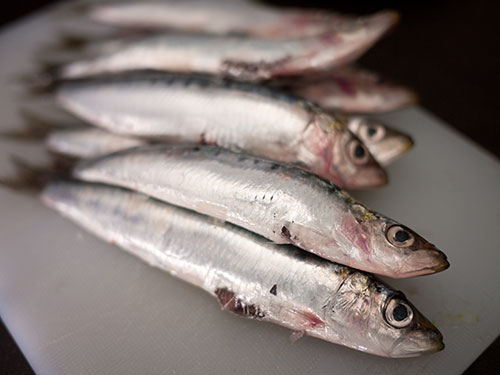
The one thing you do need a knife for is taking the heads off. You could pull them off, but that's a bit messy. So, here are the beheaded sardines, with some of the ingredients we'll be using with them later to make the plate look prettier.
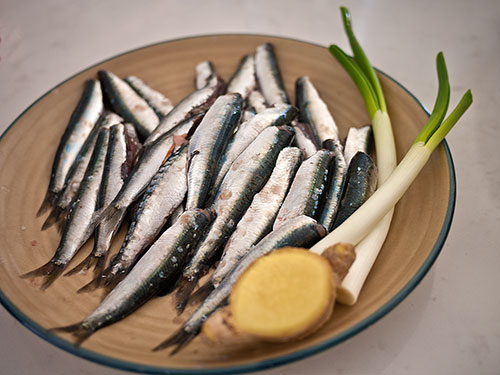
To deal with the sardines, position yourself at your sink and have a thin stream of water running out of the tap.
Take one of the sardines, and just run your thumb down the belly and pull it open. You'll see a bit of guts there; just pull it out and wash it off with the running water. (If you don't have access to running water, just use a bowl filled with clean water and swish the fish in it.)
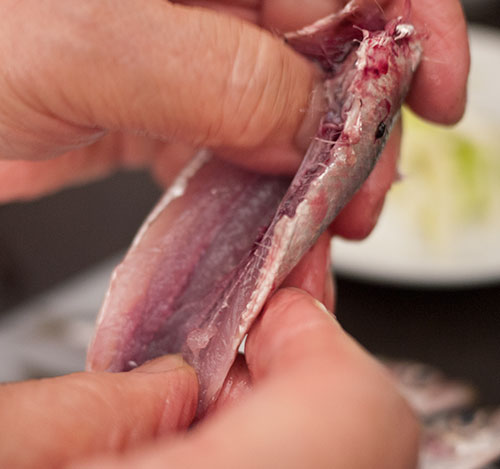
The next thing is to take out the bone. This comes off easily in one go. Pry it off at the head end, and just pull. Don't be hesitant. Give it a tug and it's gone, tail and all.
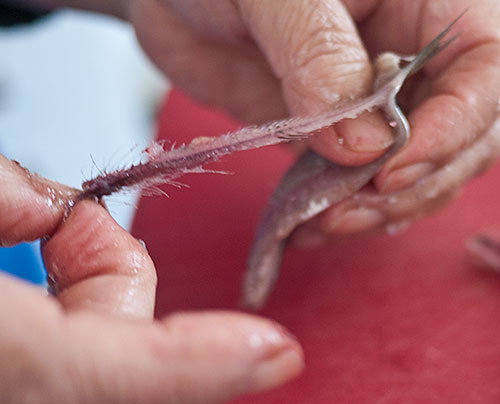
Don't throw away the bones by the way! Put them on a plate to deal with later.
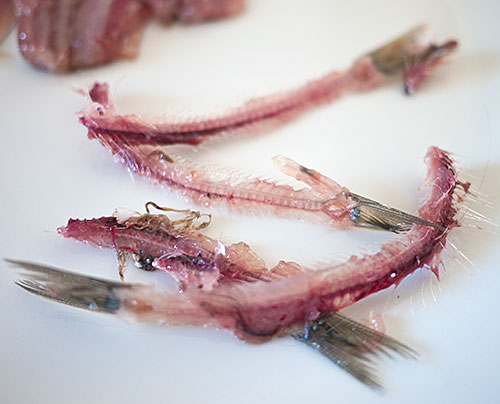
Here's the gutted and boned sardine - so easy! At this point, run your finger carefully down the surface of the fish. If you feel any little bones left in there (which you shouldn't if you ripped out the backbone properly) take them out with your fingernails or a pair of fish bone tweezers.

Here it is on the other side.
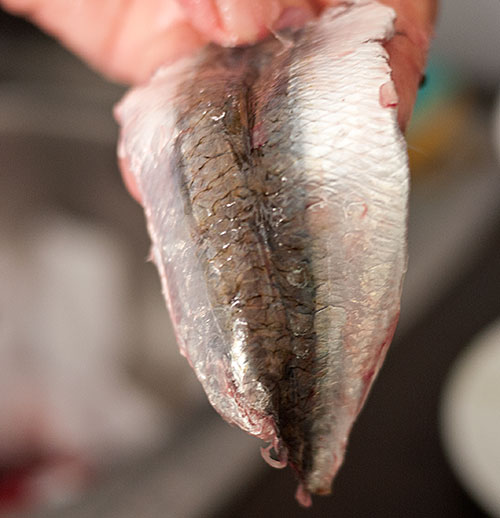
Wash each filet again to get rid of any stray bits of guts and stuff.

This next step is somewhat optional, but does improve the texture of your fish. The skin of the sardine peels off quite easily. Just pry up a corner with your thumbnail, and pull it off in one go. As with the bone, don't hesitate here or the skin will rip and it becomes harder to take it off.
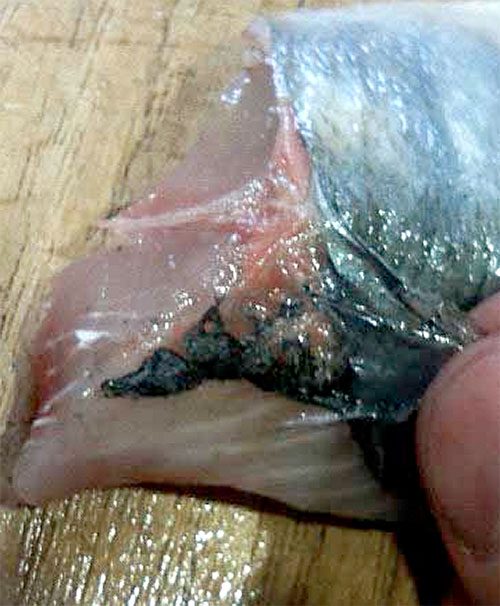
Here are the skinned filets. Put them on absorbent paper towels to drain off the excess water.
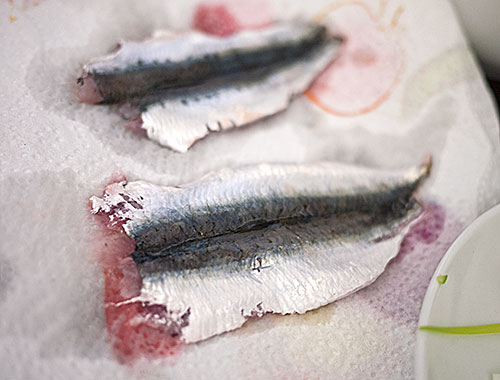
At this point you can pan-fry them in a bit of olive oil or butter (maybe coat them with flour or cornstarch first), or marinate them, or whatever you like to do with such fish. You can even turn it into sushi!
Recipes using fresh sardines
- Here is a classic way to use sardines, Iwashi no tsuire-jiru - Sardine balls in clear soup..
- A frugal way to use up the bones: Fishbone crackers
Japanese Cooking 101, Lesson 5 extra: Iwashi no Tsumire-jiru (イワシのつみれ汁) - Sardine balls in clear soup
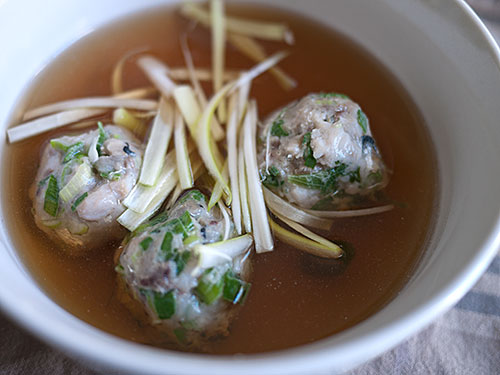
Now that you know how to gut, bone and clean sardines, one of the nicest ways to eat the sardines is to turn them into little fish balls which can be floated in a hot pot, pan-fried, and so on - or most classically, served in a clear soup. The ginger and onion takes away any kind of 'fishy' taste. You can even serve this in cold soup for a refreshing change. They are very healthy too, since sardines are one of the best sources of the heart-healthy omega-3 fatty acids EPA and DHA.
Recipe: Iwashi no Tsumire-jiru (鰯のつみれ汁): Sardine balls in clear soup
Prep time: 20 min :: Cook time: 10 min :: Total time: 30 min
Yield: 4 servings
Serving size: 3-5 balls
Ingredients:
For the sardine balls (tsumire)
- 600g (1 lb. 6 oz) fresh sardines, weighed before gutting/deboning
- 1/4 to 1/3 teaspoon salt, to taste
- 1/2 tablespoon sake , omit if you don't have any
- 1 egg white
- 1 piece fresh ginger - about a 1cm + / 1/2 inch long piece (should make about 2 teaspoons of grated ginger)
- 2-3 stalks green onion, about 1 cup chopped
- cornstarch or katakuriko potato starch
For the soup:
- 750ml / 3 U.S. cups dashi stock
- 1/2 teaspoon salt, to taste
- 1 teaspoon soy sauce, light soy sauce (usukuchi) is preferred but dark is ok
- green onion, ginger, mitsuba etc., for garnish
- sansho pepper, to taste
Directions:
- Gut, bone and de-skin the sardines as per the detailed instructions here (link).

- Finely chop the green onions - you shoul have about 1 cup's worth. Peel and grate the ginger. (No photo for this step...I figure everyone knows how to do this!)
- Start chopping up the sardines. First just slice them up.
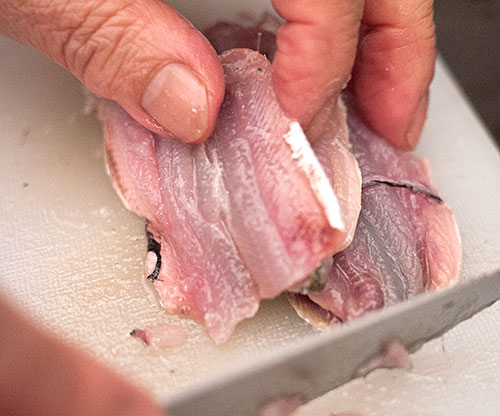
- Keep chopping the fish until the pieces get smaller and smaller.You can also bash the mixture with the side of your knife occasionally.
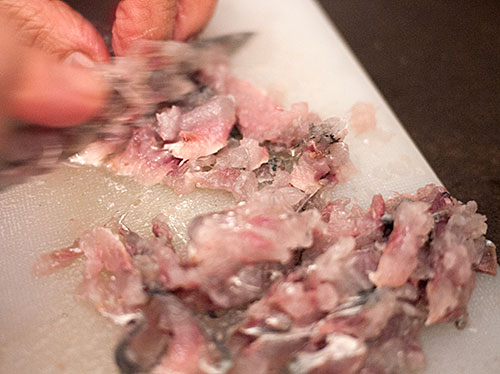
- They should get to about this consistency - rather like rough ground meat. (You can chop up the fish in a food processor if you prefer: use the pulse function so you don't grind them into a paste.)
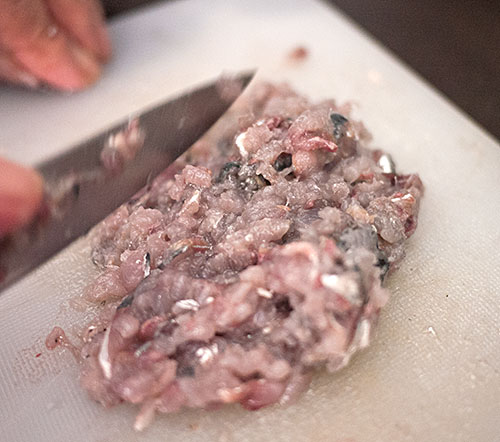
- Put the chopped up fish, ginger, green onion, sake, salt and egg white in a bowl. Mix together thoroughly with your hands until it forms a slightly sticky paste.
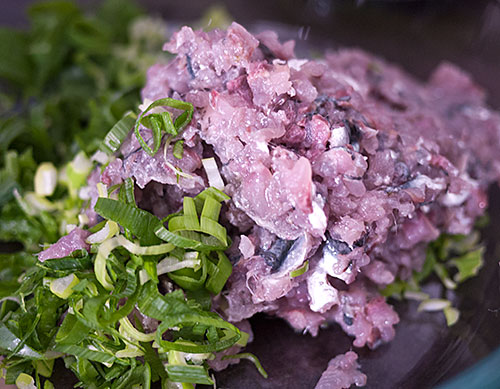
- Form into balls with moistened hands. (Some people prefer to use two spoons that have been dipped in oil to form the balls, but I just use my hands.) You should have an equal number of balls per serving, around 3-5.
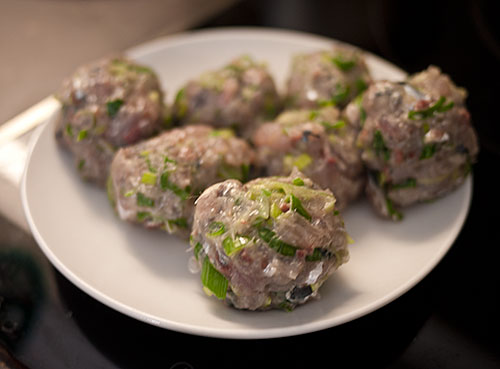
- Lightly roll the balls in cornstarch (cornflour) or potato starch. Drop them in a pot of simmering water, and poach for 4-6 minutes until they are firm, and white on the outside. Take them out and drain well. At this point you can use the precooked balls in hot pots, oden stew, or pan-fried gently and served on its own or with a little ginger-wasabi sauce.
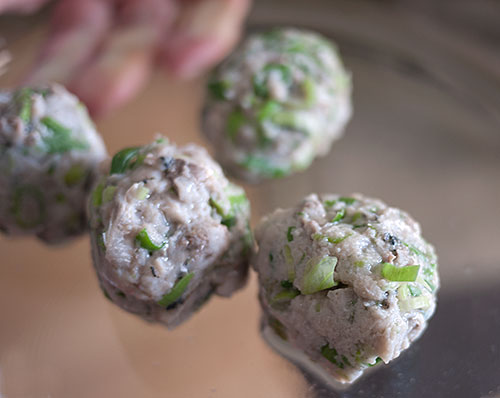
- Heat up the dashi stock. Add the tsumire (sardine balls) and gently heat through.
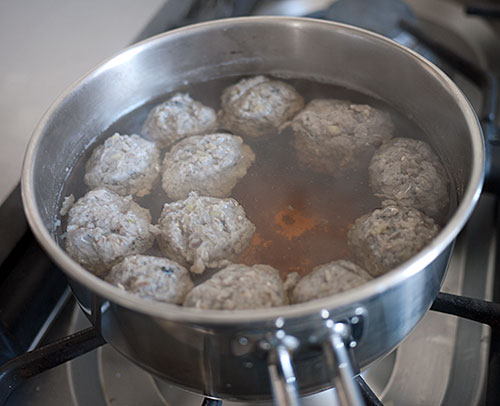
- Serve piping hot or chilled until it's ice-cold, with julienned green onion or the white part of leek, and/or julienned ginger. You can also add mitsuba, komatsuna, or even watercress to the soup. Some crunchy greens are especially nice in this if you serve it chilled. A sprinkle of sansho pepper on top is great too.

(Below for search engine purposes only)
By Makiko Itoh
Published: April 25, 2013
Type: Japanese, washoku, fish, soup
Japanese Cooking 101, Lesson 5 extra: Fish bone crackers (hone-senbei) with shoestring potatoes
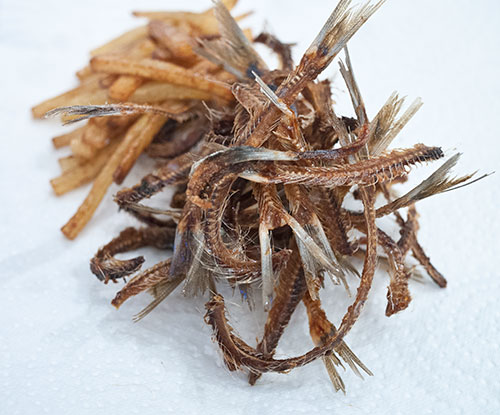
There's no need to throw away the bits of fish that you cut off when you filet them and so forth. Fish bones and heads can be kept for making soup. Or, if the bones are tender enough they can be made into delicious fish-bone crackers.
At the sushi restaurant in New York I worked at many years ago, the chefs used to serve these as extra treats to customers who sat at the counter. One of those was a lovely little girl, who used to come regularly with her father. She just loved those fish bone crackers. One year the chefs made a big batch of them and gave her a takeout box full for her birthday. She was so happy I thought her eyes were going to pop out of her head.
I've paired these with shoestring potatoes, which taste surprisingly sweet next to the umami-rich fish bones. The type of potato is important - choose a nice firm waxy type, not a floury type like Idaho baking potatoes. Alternatively you can use sweet potatoes.
Recipe: Fish bone crackers (hone-senbei 骨煎餅) with shoestring potatoes
A frugal way to deal with the bones taken out of small fish like sardines. Tip: Always fry the potatoes before you fry the bones, or the potatoes will take on the flavor of the fish.
Prep time: 15 min :: Cook time: 10 min :: Total time: 25 min
Yield: 2 servings
Ingredients:
- 16 to 20 fish bones from fresh sardines
- 2 Yukon Gold or Bintje potatoes, or similar firm potatoes, medium sized
- salt, to taste
- flour or cornstarch, to dust the fish bones
- oil, for frying
Directions:
- These are the fish bones taken out of the fish. Wash them off, and pat them dry with paper towel. Leave to dry out a bit on a plate for an hour. (Do this in the refrigerator if the weather is hot, or if you have some feline overlords about.)

- Peel the potatoes and cut them into small matchsticks. Rinse them and then pat them dry, and leave on a sieve to dry out some more until you're ready to fry everything.
- When you are ready to cook and while the oil is heating up, coat the fish lightly with flour or cornstarch.
- Heat up some oil for frying. Heat the oil to a low cooking heat, about 170°C / 340°F (see this for how to gauge frying oil temperature with wooden chopsticks). Fry the potatoes until cooked but not browning yet. Take them out and drain.
- Heat up the oil until it reaches the high range, about 180°C / 355°F. Put in the pre-cooked potatoes and fry until a golden brown. Take out and drain.
- Put the fish bones in and fry until golden brown and crispy. Take out and drain.
- Lightly salt the fish and the potatoes. Serve as a snack or appetizer. It goes very well with beer.
(Below is for search engine purposes)
By Makiko Itoh
Published: April 26, 2013
Type: Japanese, fish, washoku, appetizer